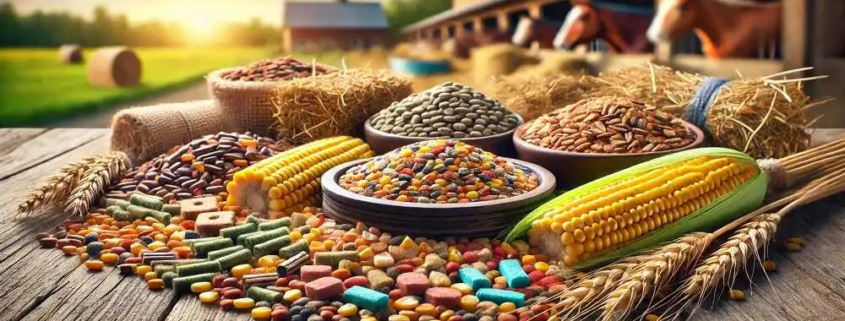Top Trends Shaping the Future of Animal Feed Production
Animal Feed Market Trends & Insights
Animal feed plays a significant role in supplying nutrients for livestock growth, health, and productivity, making it an integral part of modern livestock production. Feeds consist of various nutrient components, including proteins, carbohydrates, vitamins, and minerals, formulated to meet the dietary needs of different animal species. The aquaculture industry, using feeds like fish meal, as well as pet care and poultry farming, have increasingly adopted these solutions. Supplementation leads to increased milk production, improved egg-laying abilities, and enhanced meat quality. Well-formulated feeds result in faster growth rates, better feed conversion efficiency, and reduced disease susceptibility, contributing to overall animal well-being. Product types include complete feeds, roughage feeds, and concentrate feeds.
The rising demand for quality livestock products like eggs, milk, and meat is a key driver behind the global demand for animal feeds. These feeds ensure animals receive essential nutrients for healthy growth, development, and welfare. By incorporating such feeds, producers can create nutrient-rich animal products. According to the eleventh edition of Alltech’s annual feed production survey, global feed production reached 1.266 billion metric tons in 2022.
Explore the Animal Feed Market in Depth
This overview highlights key trends. Our comprehensive report offers detailed insights, market forecasts, and competitive analysis to guide your strategy in the global animal feed industry.
- ✅ Market Size & Growth Projections
- ✅ Regional Demand & Application Trends
- ✅ Key Player Strategies & Innovations

Source: Alltech
Top Trends Shaping the Future of Animal Feed Production
- Sustainable and eco-friendly feed ingredients
- Precision nutrition and customized feed solutions
- Digital transformation and smart farming technologies
- Focus on animal health and welfare
- Regulatory changes and globalization
- Consumer-driven changes
Let’s discuss each one in detail.
1. Sustainable and Eco-Friendly Feed Ingredients
Consumers and producers are seeking alternative protein sources to mitigate the environmental impact of traditional feed ingredients. These include insect proteins, algae proteins, and single-cell proteins from bacteria or fungi, reducing reliance on soy and fishmeal, which are criticized for ecological harm. The industry is also embracing a circular economy by using food industry byproducts, such as food waste or agricultural leftovers, to minimize waste and carbon footprint.
2. Precision Nutrition and Customized Feed Solutions
Advances in biochemistry and data analytics enable precision nutrition, tailoring feed formulations to specific species, breeds, or individual animals to optimize growth and reduce waste. Nutrigenomics, an emerging field, studies how nutrients affect gene expression, allowing specialized feeds to enhance growth, health, and efficiency while promoting sustainable agriculture.
3. Digital Transformation and Smart Farming Technologies
The integration of big data analytics and IoT devices is transforming feed production. Smart sensors monitor feed quality, animal health, and environmental factors in real time, enabling proactive adjustments to feeding schedules and reducing waste. Robotics, such as those used by Aigen and EcoRobotix, perform tasks like planting, weeding, and harvesting, addressing labor shortages and improving efficiency.
Understand the Smart Sensors Market
Smart sensors are driving efficiency in animal feed production. Our report provides insights into market size, technological advancements, and key applications.
4. Focus on Animal Health and Welfare
Feeds are evolving to improve animal health beyond basic nutrition, incorporating prebiotics, probiotics, and enzymes to enhance gut health, boost immunity, and reduce antibiotic use. Stricter regulations and consumer demand for antibiotic-free products are driving the adoption of natural supplements like organic acids, plant extracts, and essential oils.
5. Regulatory Changes and Globalization
The animal feed sector faces stricter regulations on quality, safety, and environmental impact, requiring producers to invest in compliance. This includes adhering to new rules on feed additives, labeling, and sustainability. Global supply chain challenges highlight the need for diversified raw material sources and enhanced local production to improve resilience.
6. Consumer-Driven Changes
Consumers are increasingly concerned about the origins of their food, driving demand for transparency in feed supply chains. Technologies like blockchain are being adopted to ensure traceability. The rise of lab-grown and plant-based meat is also influencing feed ingredients, requiring new plant-based or cell-cultured raw materials, potentially reshaping feed formulations.
Conclusion
The future of animal feed production is being shaped by consumer demands, sustainability goals, and technological advancements. Companies that proactively adapt to these trends and invest in research and development will be well-positioned for success. These efforts contribute to a more sustainable, transparent, and efficient food system, driving growth in the animal agriculture sector.
Go from Insight to Action with Our Market Research
You’ve seen the trends. Now, access the detailed data and strategic analysis needed to stay ahead in the animal feed market. Explore our related reports.
Each report includes comprehensive data, forecasts, and competitive analysis to empower your business decisions.



